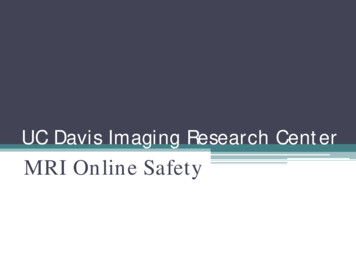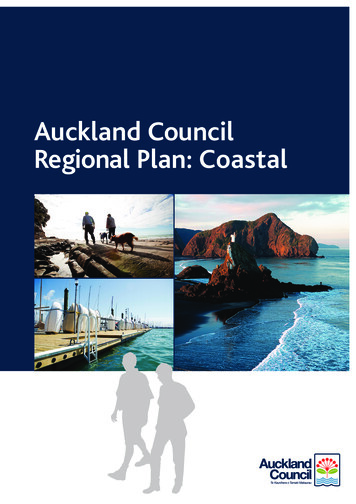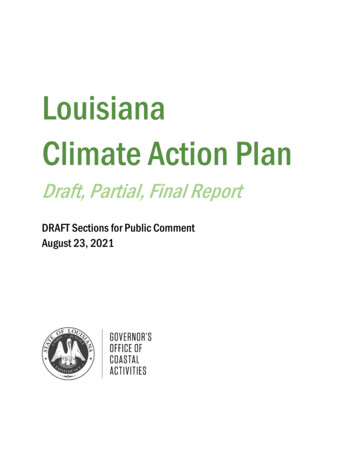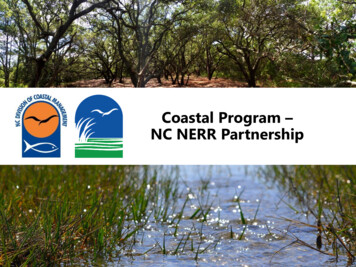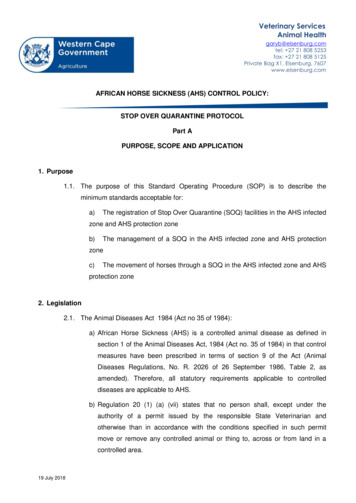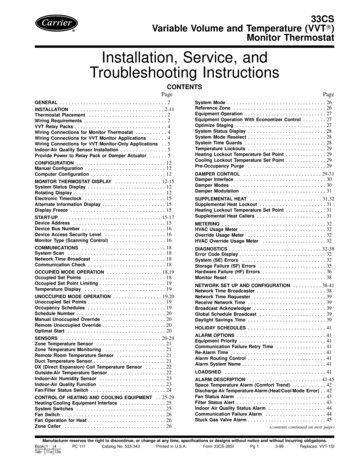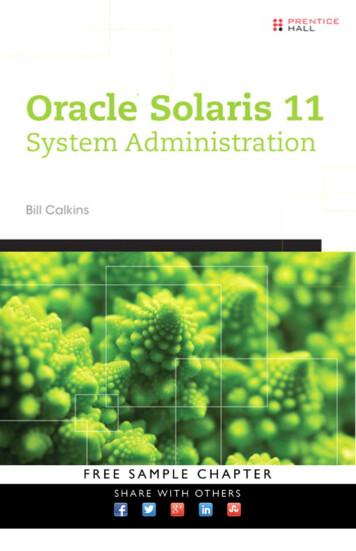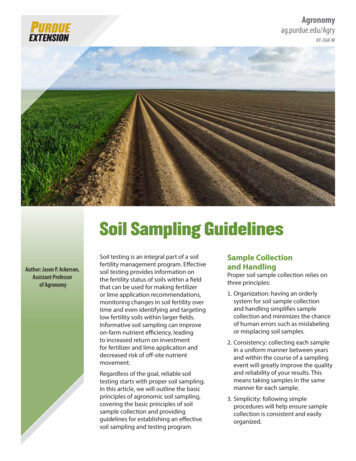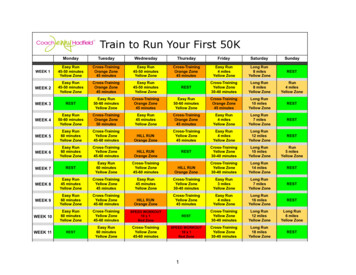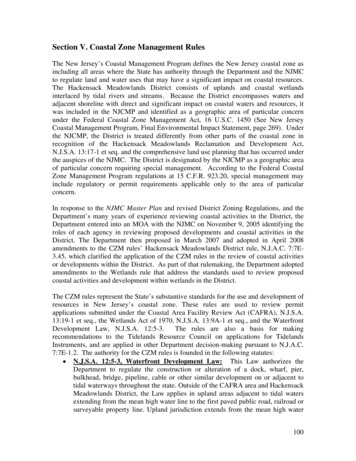
Transcription
Section V. Coastal Zone Management RulesThe New Jersey’s Coastal Management Program defines the New Jersey coastal zone asincluding all areas where the State has authority through the Department and the NJMCto regulate land and water uses that may have a significant impact on coastal resources.The Hackensack Meadowlands District consists of uplands and coastal wetlandsinterlaced by tidal rivers and streams. Because the District encompasses waters andadjacent shoreline with direct and significant impact on coastal waters and resources, itwas included in the NJCMP and identified as a geographic area of particular concernunder the Federal Coastal Zone Management Act, 16 U.S.C. 1450 (See New JerseyCoastal Management Program, Final Environmental Impact Statement, page 269). Underthe NJCMP, the District is treated differently from other parts of the coastal zone inrecognition of the Hackensack Meadowlands Reclamation and Development Act,N.J.S.A. 13:17-1 et seq. and the comprehensive land use planning that has occurred underthe auspices of the NJMC. The District is designated by the NJCMP as a geographic areaof particular concern requiring special management. According to the Federal CoastalZone Management Program regulations at 15 C.F.R. 923.20, special management mayinclude regulatory or permit requirements applicable only to the area of particularconcern.In response to the NJMC Master Plan and revised District Zoning Regulations, and theDepartment’s many years of experience reviewing coastal activities in the District, theDepartment entered into an MOA with the NJMC on November 9, 2005 identifying theroles of each agency in reviewing proposed developments and coastal activities in theDistrict. The Department then proposed in March 2007 and adopted in April 2008amendments to the CZM rules’ Hackensack Meadowlands District rule, N.J.A.C. 7:7E3.45, which clarified the application of the CZM rules in the review of coastal activitiesor developments within the District. As part of that rulemaking, the Department adoptedamendments to the Wetlands rule that address the standards used to review proposedcoastal activities and development within wetlands in the District.The CZM rules represent the State’s substantive standards for the use and development ofresources in New Jersey’s coastal zone. These rules are used to review permitapplications submitted under the Coastal Area Facility Review Act (CAFRA), N.J.S.A.13:19-1 et seq., the Wetlands Act of 1970, N.J.S.A. 13:9A-1 et seq., and the WaterfrontDevelopment Law, N.J.S.A. 12:5-3.The rules are also a basis for makingrecommendations to the Tidelands Resource Council on applications for TidelandsInstruments, and are applied in other Department decision-making pursuant to N.J.A.C.7:7E-1.2. The authority for the CZM rules is founded in the following statutes: N.J.S.A. 12:5-3, Waterfront Development Law: This Law authorizes theDepartment to regulate the construction or alteration of a dock, wharf, pier,bulkhead, bridge, pipeline, cable or other similar development on or adjacent totidal waterways throughout the state. Outside of the CAFRA area and HackensackMeadowlands District, the Law applies in upland areas adjacent to tidal watersextending from the mean high water line to the first paved public road, railroad orsurveyable property line. Upland jurisdiction extends from the mean high water100
line landward a minimum of 100 feet and not exceeding 500 feet. Within thisarea, construction, reconstruction, alteration, expansion or enlargement of anystructure, or the excavation or filling of any area are subject to this Law;N.J.S.A. 13:9A-1 et seq., Wetlands Act f 1970: This Act authorizes theDepartment to regulate activities on coastal wetlands that have been delineatedand mapped by the Department. Examples of regulated activities includeexcavation, dredging, fill or placement of a structure on a mapped coastalwetland;N.J.S.A. 13:19-1 et seq., Coastal Area Facility Review Act (CAFRA):CAFRA applies to projects near coastal waters in the southern part of the State.The CAFRA area begins where the Cheesequake Creek enters Raritan Bay in OldBridge, Middlesex County. It extends south along the coast around Cape May,and then north along the Delaware Bay ending at Kilcohook National WildlifeRefuge in Salem County. The inland limit of the CAFRA area is an irregular linethat follows public roads, railroad tracks, and other features. The width of theCAFRA area varies from a few thousand feet to nearly 17 miles. The law dividesthe CAFRA area into zones, and regulates different types and sizes ofdevelopment in each zone. Regulated activities within the CAFRA area include awide variety of residential, commercial, industrial or public development such asconstruction, relocation, and enlargement of buildings and structures; andassociated work such as excavation, grading, site preparation and the installationof shore protection structures;N.J.S.A. 13:1D-9, Powers of the Department: This statute provides that theDepartment shall formulate comprehensive policies for the conservation of thenatural resources of the State, the promotion of environmental protection and theprevention of pollution of the environment of the State; andN.J.S.A. 13:1D-29 et seq., Ninety-Day Construction Law: This Chapterestablishes application submission requirements, public notice requirements, feesand review procedures for permit applications submitted to the Department underthe Waterfront Development Law, N.J.S.A. 12:5-3; Coastal Area Facility ReviewAct, N.J.S.A. 13:19-1 et seq.; Wetlands Act of 1970, N.J.S.A. 13:9A-1 et seq. andFlood Hazard Area Control Act, N.J.S.A. 58:16A -1 et seq. as well as sewerextensions under the Water Pollution Control Act, N.J.S.A. 58:10A-1 et seq.Table C, Routine Program Change, Coastal Zone Management rules, N.J.A.C. 7:7E-3.27Wetlands and 3.45 Hackensack Meadowlands District, compares the CZM rules as theyexisted prior to the April 2008 amendments with the rules as amended April 7, 2008 andcontains an analysis describing the changes between these regulations. These changes donot change the program approvability area of boundaries nor do they change theDistrict’s designation as a special management area. While the changes may affect theprogram approvability areas of uses subject to management, authorities and organization,or consideration of the national interest, these changes are not substantial for the reasonsdescribed in the analysis portion of Table C. A copy of the rule text subject to theRoutine Program Change is included in this submission.101
Table CRoutine Program ChangeCoastal Zone Management rules, N.J.A.C. 7:7EWetlands, N.J.A.C. 7:7E-3.27 and Hackensack Meadowlands District, N.J.A.C. 7:7E-3.45September 8, 2009Legal Citation7:7E-3.27(b) WetlandsDescription of changeMODIFIED:Specified that the standards usedto review proposed coastalactivities and development withinthe Hackensack MeadowlandsDistrict (District) are those of theFreshwater Wetlands ProtectionAct rules at N.J.A.C. 7:7A-4, 5and 7EnforcementMechanismN.J.S.A. 12:5-3N.J.S.A. 13:1D-9N.J.S.A. 13:1D-29 et seq.N.J.S.A. 13:9A-1 et seq.N.J.S.A. 13:19-1 et seq.State Permitting ProgramDateadopted byState04/07/2008DateEffectivein State04/07/2008Significance of ChangeDevelopment in all tidal and freshwater wetlands located outside ofthe District and north of the Raritan River is subject to thepermitting requirements of the Freshwater Wetlands Protection Actrules, N.J.A.C. 7:7A. However, development in wetlands located inthe District does not require a freshwater wetland permit, exceptthat the discharge of dredged or fill materials may require a permitissued under the Federal Clean Water Act, 33 U.S.C. 1251, andapplicable State laws, under a permitting program administered bythe State. The Department addresses proposed coastal activitiesand development in wetlands in the District through the WaterfrontDevelopment Law, N.J.S.A. 12:5-3, Water Quality Certificates underSection 401 of the Clean Water Act, 33 U.S.C. 1251, and the Federalconsistency provisions under Section 307 of the Federal CoastalZone Management Act, 16 U.S.C. 1451. Prior to this rule change,the standards for review of such activities were those of the CZMrules’ Wetlands rule, N.J.A.C. 7:7E-3.27.Through the Department’s experience in reviewing wetland impactswithin and outside of the District, the Department determined thatthe conditions, limits and requirements of the Freshwater WetlandsProtection Act rules for individual and general permits are theappropriate standards to apply to development in wetlands in theDistrict, rather than those of the CZM rules at N.J.A.C. 7:7E-3.27(c).Under N.J.A.C. 7:7E-3.27(c) development in wetlands is prohibitedunless the development meets the following four conditions: (1)requires water access or is water oriented as a central purpose ofthe basic function of the activity (this only applies to developmentproposed on or adjacent to waterways); (2) has no prudent orfeasible alternative on a non-wetland site; (3) will result in minimum102
Legal CitationDescription of changeEnforcementMechanismDateadopted byStateDateEffectivein State7:7E-3.27(b) (continued)7:7E-3.45(a) HackensackMeadowlands DistrictSignificance of Changefeasible alteration or impairment of natural tidal circulation; and (4) willresult in minimum feasible alteration or impairment of the naturalcontour or the natural vegetation of the wetlands. The Departmentcompared these four requirements that were previously used to reviewcoastal activities and development proposed within wetlands in theDistrict with the conditions, limits, and requirements for reviewingdevelopment in tidal and freshwater wetlands located outside of theHackensack Meadowlands and north of the Raritan River, found atN.J.A.C. 7:7A-4, 5, and 7. These are the general and individual permitstandards. A general permit is issued only after an environmentalanalysis has been conducted and the Department has determined thatthe regulated activities will cause only minimal adverse environmentalimpacts when performed separately, will have only minimal cumulativeadverse impacts on the environment, and will cause only minor impactson freshwater wetlands and State open waters. An individual permit isissued only after consideration of alternatives and minimization.Additional criteria are applied to non-water dependent activities.MODIFIED:Recalculated acreage of theDistrict; updated title of the“Hackensack MeadowlandsReclamation Act;” andrepealed Figure 11N.J.S.A. 12:5-3N.J.S.A. 13:1D-9N.J.S.A. 13:1D-29 et seq.N.J.S.A. 13:9A-1 et seq.N.J.S.A. 13:19-1 et seq.State Permitting Program04/07/0804/07/08The conditions, limits, and requirements at N.J.A.C. 7:7A-4, 5, and 7reflect the considerations of the previous requirements at N.J.A.C.7:7E-3.27(c). The Department determined to use the conditions, limitsand requirements of N.J.A.C. 7:7A-4, 5 and 7 to review developmentand coastal activities proposed in wetlands in the District because thosestandards are appropriately protective of wetlands resources. Themitigation requirements of the CZM rules’ Wetlands rule will continue toapply to any coastal activity or development in wetlands in the District,unless the conditions, limits or requirements of N.J.A.C. 7:7A-4 and 5do not require mitigation. Therefore, the Department does not considerthe changes to the CZM Wetlands rule to be a substantial change tospecial management areas, uses subject to management, authoritiesand organization or consideration of the national interest.Prior to this rulemaking, the rule stated that the District encompassed19,730 acres of water, coastal wetlands and associated uplands.According to the New Jersey Meadowlands Commission (NJMC) staff,this acreage was calculated using municipal tax records andplanimetering paper copies of tax maps from 1969. In revising theMaster Plan, the acreage of the District was recalculated using digitizedtax maps which correct inaccuracies.103
Legal CitationDescription of changeEnforcementMechanismDateadopted byStateDateEffectivein StateSignificance of ChangeThe recalculated acreage of the District is 19,485 acres. Therefore, therule has been changed to reflect the recalculated acreage.Theboundary of the District did not change.The language identifying the NJMC as the State-level managementagency was deleted from the definition of this special area because themanagement agency is not relevant to the definition. Languageindicating that the NJMC is the lead planning and management agencywithin the District was added to the rule rationale.The title of the Hackensack Meadowlands Reclamation Act was revisedfor accuracy.The reference to “See Figure 20” was deleted. The reference to thisfigure in chapter 1 was in error as there was no Figure 20 in Appendix1, and the Appendix 1 figure depicting the boundary of the District wasFigure 11. However, as Figure 11 was inaccurate and unnecessary interms of establishing boundaries, Appendix 1, Figure 11 was repealed.7:7E-3.45(b) recodified as (h)Hackensack MeadowlandsDistrictMODIFIED:Recodification of discussion ofroles of the Department andNew Jersey MeadowlandsCommission; Recodification ofsubsection addressing theinapplicability of theFreshwater WetlandsProtection Act to coastalactivities under thejurisdiction of the NJMC withno changes in textThus, none of these changes are substantial changes to specialmanagement areas, uses subject to management, authorities andorganization or consideration of the national interest.Prior to this change, subsection (b) of the rule generally described theroles of the Department and the NJMC in the NJCMP. In 1980, it wasdetermined that the Master Plan was consistent with the goals of theNJCMP. While subsection (b) explained that the Master Plan andDistrict zoning regulations were adopted as part of the NJCMP, it didnot set forth the specific development standards within the District butprovides background information. The discussion of roles remains inthe CZM rules, recodified within the rule rationale, subsection (h).Accordingly, this is not a substantial change to special managementareas, uses subject to management, authorities and organization orconsideration of the national interest.Changes to the codification of subsections with no changes in text areconsidered to be minor changes to the program that do not affect the 5program approvability areas but are included for notification purposes.104
Legal Citation7:7E-3.45(b)-(g)Hackensack MeadowlandsDistrictDescription of changeADDED:Clarified the application of theCZM rules in the review ofcoastal activities anddevelopments within theDistrictIncorporation of theNovember 9, 2005 MOAbetween the Department andthe NJMCEnforcementMechanismDateadopted byStateDateEffectivein StateSignificance of ChangeUnder the NJCMP, the District is treated differently than other partsof the coastal zone because of the comprehensive land use decisionmaking governed by a regional agency which is part of Stategovernment and has objectives and policies compatible with theNJCMP. The NJMC Master Plan and District zoning regulationswereadopted as part of the approved CMP in 1980. Prior to thisrulemaking, the rule stated that the Master Plan and zoningregulations would be the review standards when the NJMC wasreviewing a proposed coastal activity or development.Through this rulemaking, the standards for proposed coastalactivities or developments within the District were clarified. Thesestandards are dependent upon whether a zoning certificate orstatement of consistency from the NJMC is required and whether theproposed activity or development is subject to the WaterfrontDevelopment Law. The Department can not issue a WaterfrontDevelopment permit, Federal Consistency Determination, or WaterQuality Certificate (except for those that do not require a zoningcertificate from the NJMC), without a statement of consistency,zoning certificate or resolution from the NJMC approving the activityor development, from the NJMC. The review process outlined in theMOA described below has been incorporated into the rule to codifythis process. (See program change analysis for the incorporation ofthe MOA into the NJCMP).In the District, the Waterfront Development Law applies to coastalactivities or developments located in a tidal waterway or in any landslying thereunder, up to and including the mean high water line.Accordingly, the rule provides that all applicable CZM rules apply tothese activities or developments regardless of whether a zoningcertificate or statement of consistency from the NJMC is required.Certain activities and developments do not require a zoningcertificate from the NJMC and do not follow any alternative reviewprocess with the New Jersey Meadowlands Commission and thus arenot subject to management by the NJMC. Examples of suchactivities and developments are coastal activities on Federal lands,municipal, county, or State highway projects (e.g. New JerseyTurnpike), and railroad projects. Hence, the rule provides that these105
Legal Citation7:7E-3.45(b)-(g) (continued)Description of changeEnforcementMechanismDateadopted byStateDateEffectivein StateSignificance of Changecoastal activities and developments must comply with all applicableCZM rules.The District is designated as a geographic area of particular concernrequiring special management under the NJCMP. According to 15C.F.R. 923.20, special management may include regulatory or permitrequirements applicable only to the area of particular concern. Assuch, the Master Plan and zoning regulations are used indetermining the acceptability of activities and development withinthe District. As described above, the changes to the rule set forth aprocess for the review of coastal activities and developments withinthe District and the applicability of the Master Plan, zoningregulations and CZM rules. In addition, the changes clarify the rolesof the Department and NJMC in the review of coastal activities anddevelopments within the District and are in keeping with therelationship between the Department and NJMC as described in the1980 program document which was formalized through theNovember 9, 2005 MOA. Therefore, the above changes are notsubstantial changes to special management areas, uses subject tomanagement, authorities and organization or consideration of thenational interest.106
Rule TextWetlands rule, N.J.A.C. 7:7E-3.27Hackensack Meadowlands District rule, N.J.A.C. 7:7E-3.45Changes to existing rule text approved by OCRM are shown as follows:Additions indicated in underlined boldface; andDeletions shown in [bracketed strikethrough].7:7E-3.27 WetlandsChanges to existing text approved by OCRM(a) (No change.)(b) Development in wetlands defined under the Freshwater Wetlands Protection Act[of 1987] is prohibited unless the development is found to be acceptable under theFreshwater Wetlands Protection Act Rules (N.J.A.C. 7:7A), except as provided at (b)1below. Pursuant to the Freshwater Wetlands Protection Act, N.J.S.A. 13:9B-6,coastal activities under the jurisdiction of the New Jersey MeadowlandsCommission shall not require a Freshwater Wetlands permit, or be subject totransition area requirements of the Freshwater Wetlands Protection Act, exceptthat discharge of dredged or fill materials may require a permit issued under theprovisions of Section 404 of the Federal Water Pollution Control Act of 1972 asamended by the Federal Clean Water Act of 1977, or under an individual or generalpermit program administered by the State under the provisions of the Federal Actand applicable State laws. Accordingly, under this rule the Department does notexert jurisdiction under the Freshwater Wetlands Protection Act, N.J.S.A. 13:9B-1et seq., in the Hackensack Meadowlands District. However, the Department shall,in accordance with N.J.S.A. 13:9B-6 and applicable law, review any such coastalactivity or development as follows:1. For the purposes of reviewing a coastal activity or development that proposesthe placement of dredged or fill materials in wetlands located below the mean highwater line in the Hackensack Meadowlands District under the WaterfrontDevelopment Law, N.J.S.A. 12:5-3, Federal Consistency provisions of the FederalCoastal Zone Management Act, 16 U.S.C. 1451 et seq., or water quality certificationunder Section 401 of the Federal Clean Water Act 33 U.S.C. 1251 et seq., theDepartment shall use the conditions, limits, and requirements governing activities ordevelopments in wetlands set forth in N.J.A.C. 7:7A-4, 5 and 7. For the purposes ofreviewing a coastal activity or development that proposes the placement of dredgedor fill materials in wetlands above the mean high water line that does not require azoning certificate, resolution or statement of consistency from the New JerseyMeadowlands Commission pursuant to N.J.A.C. 7:7E-3.45(c) in the HackensackMeadowlands District under the Federal Consistency provisions of the FederalCoastal Zone Management Act, 16 U.S.C. 1451 et seq., or water quality certificationunder Section 401 of the Federal Clean Water Act 33 U.S.C. 1251 et seq., theDepartment shall use the conditions, limits, and requirements governing activities ordevelopments in wetlands set forth in* N.J.A.C. 7:7A-4, 5 and 7.107
i. The mitigation requirements at (h) below shall apply to any coastal activity ordevelopment reviewed under this subsection, unless, where the coastal activity ordevelopment is reviewed under the conditions, limits, and requirements at N.J.A.C.7:7A-4 and 5, those conditions, limits, and requirements do not require mitigation.(c) –(h) (No change.)Rule text subject to RPC(a) Wetlands or wetland means an area that is inundated or saturated by surface wateror groundwater at a frequency and duration sufficient to support, and that under normalcircumstances does support, a prevalence of vegetation typically adapted for life insaturated soil conditions, commonly known as hydrophytic vegetation.1. Wetlands areas are identified and mapped on the following:i. National Wetlands Inventory Maps produced by the U.S. Fish and Wildlife Serviceat a scale of 1:24,000 (generalized locations only);ii. Coastal wetland maps, pursuant to the Wetlands Act of 1970 (N.J.S.A. 13:9A-1 etseq.) prepared by the DEP at a scale of 1:2,400; andiii. Freshwater wetland maps prepared by DEP at a scale of 1:12,000 (generalizedlocations only).Note: Maps referenced in (a)1ii and iii above are available from the DEP Map andPublications sales office (609) 777-1038.2. Generalized locations of some wetland types can be found in county soil surveysprepared by the U.S. Department of Agriculture, Soil Conservation Service.3. The maps referenced under (a)1i, iii, and 2 above shall be useful as an indicator toassist in the preliminary determination of the presence or absence of wetlands only. Theyhave been determined to be unreliable for the purposes of locating the actual wetlandsboundary on a specific site.4. All tidal and inland wetlands, excluding the delineated tidal wetlands definedpursuant to N.J.A.C. 7:7-2.2, shall be identified and delineated in accordance with theUSEPA three-parameter approach (that is, hydrology, soils and vegetation) specifiedunder N.J.A.C. 7:7A-1.4 of the Freshwater Wetlands Protection Act Rules.(b) Development in wetlands defined under the Freshwater Wetlands Protection Actis prohibited unless the development is found to be acceptable under the FreshwaterWetlands Protection Act Rules (N.J.A.C. 7:7A), except as provided at (b)1 below.Pursuant to the Freshwater Wetlands Protection Act, N.J.S.A. 13:9B-6, coastal activitiesunder the jurisdiction of the New Jersey Meadowlands Commission shall not require aFreshwater Wetlands permit, or be subject to transition area requirements of theFreshwater Wetlands Protection Act, except that discharge of dredged or fill materialsmay require a permit issued under the provisions of Section 404 of the Federal WaterPollution Control Act of 1972 as amended by the Federal Clean Water Act of 1977, orunder an individual or general permit program administered by the State under theprovisions of the Federal Act and applicable State laws. Accordingly, under this rule theDepartment does not exert jurisdiction under the Freshwater Wetlands Protection Act,N.J.S.A. 13:9B-1 et seq., in the Hackensack Meadowlands District. However, theDepartment shall, in accordance with N.J.S.A. 13:9B-6 and applicable law, review anysuch coastal activity or development as follows:108
1. For the purposes of reviewing a coastal activity or development that proposes theplacement of dredged or fill materials in wetlands located below the mean high water linein the Hackensack Meadowlands District under the Waterfront Development Law,N.J.S.A. 12:5-3, Federal Consistency provisions of the Federal Coastal ZoneManagement Act, 16 U.S.C. 1451 et seq., or water quality certification under Section 401of the Federal Clean Water Act 33 U.S.C. 1251 et seq., the Department shall use theconditions, limits, and requirements governing activities or developments in wetlands setforth in N.J.A.C. 7:7A-4, 5 and 7. For the purposes of reviewing a coastal activity ordevelopment that proposes the placement of dredged or fill materials in wetlands abovethe mean high water line that does not require a zoning certificate, resolution or statementof consistency from the New Jersey Meadowlands Commission pursuant to N.J.A.C.7:7E-3.45(c) in the Hackensack Meadowlands District under the Federal Consistencyprovisions of the Federal Coastal Zone Management Act, 16 U.S.C. 1451 et seq., or waterquality certification under Section 401 of the Federal Clean Water Act 33 U.S.C. 1251 etseq., the Department shall use the conditions, limits, and requirements governingactivities or developments in wetlands set forth in* N.J.A.C. 7:7A-4, 5 and 7.i. The mitigation requirements at (h) below shall apply to any coastal activity ordevelopment reviewed under this subsection, unless, where the coastal activity ordevelopment is reviewed under the conditions, limits, and requirements at N.J.A.C. 7:7A4 and 5, those conditions, limits, and requirements do not require mitigation.(c) Development of all kinds in all other wetlands not defined in (b) above isprohibited unless the Department can find that the proposed development meets thefollowing four conditions:1. Requires water access or is water oriented as a central purpose of the basic functionof the activity (this rule applies only to development proposed on or adjacent towaterways). This means that the use must be water dependent as defined in N.J.A.C.7:7E-1.8;2. Has no prudent or feasible alternative on a non-wetland site;3. Will result in minimum feasible alteration or impairment of natural tidal circulation(or natural circulation in the case of non-tidal wetlands); and4. Will result in minimum feasible alteration or impairment of natural contour or thenatural vegetation of the wetlands.(d) In particular, dumping solid or liquid wastes and applying or storing certainpesticides on wetlands are prohibited.(e) No action by the Commissioner shall prohibit, restrict or impair the exercise orperformance of the powers and duties conferred or imposed by law on the Department ofEnvironmental Protection, the Natural Resource Council and the State Mosquito ControlCommission in said Department, the Department of Health, or any mosquito control orother project or activity operating under or authorized by the provisions of chapter 9 ofTitle 26 of Revised Statutes. This rule does not supersede the authority of the StateMosquito Commission to undertake mosquito control projects authorized by chapter 9 ofTitle 26 of the Revised Statutes.109
(f) Development that adversely affects white cedar stands such as water tabledrawdown, surface and groundwater quality changes and the introduction of non-nativeplant species is prohibited.(g) For projects which require a Waterfront Development permit, the reuse of formerdredged material disposal sites for continued dredged material disposal is conditionallyacceptable provided the following criteria are met:1. The site has been used for dredged material disposal within the past 10 years;2. The site has existing dikes or berms in sound condition, and/or has sufficient areaof previously disposed material within the previously disturbed disposal area to allow theconstruction of structurally sound dikes and berms;3. There are no anticipated adverse effects on threatened or endangered species;4. There are no colonial nesting birds present on site which would be adverselyaffected (seasonal restrictions may be required);5. No wetlands regulated pursuant to the Wetlands Act of 1970 would be adverselyaffected;6. The former dredged material disposal area is not subject to daily tidal inundation,and the vegetation community is limited primarily to scrub/shrub or phragmites; and7. The required Waterfront Development permit and Water Quality Certification areobtained.(h) If an application to disturb or destroy wetlands meets the standards for permitapproval, the Department will require the applicant to mitigate for the loss or degradationof the wetlands in accordance with the following:1. Mitigation for the loss of wetlands subject to the Freshwater Wetlands ProtectionAct, N.J.S.A. 13:9B-1 et seq., shall meet the standards of N.J.A.C. 7:7A.2. When a permit allows the disturbance or loss of wetlands by filling or other means,this disturbance or loss shall be compensated for as specified under (h)9 below unless theapplicant can prove through the use of productivity models or other similar studies, thatby restoring or creating a lesser area, there will be replacement of wetlands of equalecological value. In order to demonstrate equal ecological value, the applicant shallsurvey and provide written documentation regarding, at a minimum, existing soil,vegetation, water quality functions, flood storage
excavation, dredging, fill or placement of a structure on a mapped coastal wetland; N.J.S.A. 13:19-1 et seq., Coastal Area Facility Review Act (CAFRA): CAFRA applies to projects near coastal waters in the southern part of the State. The CAFRA area begins where the Cheesequake Creek enters Raritan Bay in Old Bridge, Middlesex County.
